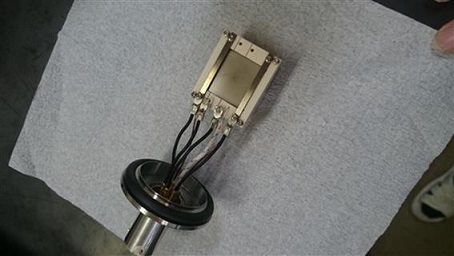
井上修平, Shuhei INOUE
略歴(C. V.)
2004.4:広島大学工学部 助手着任 (Research Associate, Hiroshima University)
2002.4-2004.3:日本学術振興会特別研究員 (JSPS Research Fellowship for Young Scientists)
2003.3:東京大学大学院工学系研究科機械工学専攻 博士後期課程修了 博士(工学)
Ph. D in Eng. (University of Tokyo)
"FT-ICRによる金属・炭素クラスターの生成と反応" 指導教官 丸山茂夫助教授(当時・現教授)
Supervisor: Prof. Shigeo MARUYAMA
2000.3:東京大学大学院工学系研究科機械工学専攻 博士前期課程修了
Master in Eng. (University of Tokyo)
"FT-ICRによるシリコンクラスターの化学反応" 指導教官 丸山茂夫助教授
Supervisor: Prof. Shigeo MARUYAMA
1998.3:慶応義塾大学理工学部機械工学科 卒業
Bachelor in Eng. (Keio University)
"超臨界域におけるアンモニアの熱伝導率の推算" 指導教員 上松公彦教授
Supervisor: Prof. Masahiko UEMATSU
広大着任以降は大学のページへ, Please visit here after FY2004.
2002.4-2004.3:日本学術振興会特別研究員 (JSPS Research Fellowship for Young Scientists)
2003.3:東京大学大学院工学系研究科機械工学専攻 博士後期課程修了 博士(工学)
Ph. D in Eng. (University of Tokyo)
"FT-ICRによる金属・炭素クラスターの生成と反応" 指導教官 丸山茂夫助教授(当時・現教授)
Supervisor: Prof. Shigeo MARUYAMA
2000.3:東京大学大学院工学系研究科機械工学専攻 博士前期課程修了
Master in Eng. (University of Tokyo)
"FT-ICRによるシリコンクラスターの化学反応" 指導教官 丸山茂夫助教授
Supervisor: Prof. Shigeo MARUYAMA
1998.3:慶応義塾大学理工学部機械工学科 卒業
Bachelor in Eng. (Keio University)
"超臨界域におけるアンモニアの熱伝導率の推算" 指導教員 上松公彦教授
Supervisor: Prof. Masahiko UEMATSU
広大着任以降は大学のページへ, Please visit here after FY2004.
Themes
Evaluation of gas sensors using carbon nanotube thin films modified with metal particles
(M1:E. Horie) Carbon nanotubes (CNTs) have the property that their electrical resistance changes when gas molecules are adsorbed. Since this reaction occurs even at room temperature, CNTs are expected to be a new gas sensor material. In this study, we aim to modify CNT gas sensors with metal nanoparticles and evaluate their response.
(M1:E. Horie) Carbon nanotubes (CNTs) have the property that their electrical resistance changes when gas molecules are adsorbed. Since this reaction occurs even at room temperature, CNTs are expected to be a new gas sensor material. In this study, we aim to modify CNT gas sensors with metal nanoparticles and evaluate their response.

Synthesis and characterization of photochromic nanoparticles
(D2:H. Takaki, JSPS DC1) A phenomenon called photochromism, in which metal oxides change color when irradiated with light, has been reported. Furthermore, it has been reported that metal oxides with photochromism have the ability to store electricity, and are expected to be used as new energy storage devices. In this study, we aim to elucidate the principle and solve the problem of abnormal self-discharge for practical use.
(D2:H. Takaki, JSPS DC1) A phenomenon called photochromism, in which metal oxides change color when irradiated with light, has been reported. Furthermore, it has been reported that metal oxides with photochromism have the ability to store electricity, and are expected to be used as new energy storage devices. In this study, we aim to elucidate the principle and solve the problem of abnormal self-discharge for practical use.

Evaluation of a simple gas sensor using CNTs
(D1:M. Zhang) The same CNTs are used, but unlike Horie's sensor, the CNTs are not placed on a substrate, but rather the CNTs are directly cross-linked to the electrode to create the detection part and evaluate its performance.
(D1:M. Zhang) The same CNTs are used, but unlike Horie's sensor, the CNTs are not placed on a substrate, but rather the CNTs are directly cross-linked to the electrode to create the detection part and evaluate its performance.

Analysis of Work Function and Ionization Potential of Photochromic Nanoparticles by Photoelectron Yield Spectroscopy
(M2:Y. Suzuki) We have developed a photoelectron yield spectrometer to measure whether there is a difference in the ionization potential of photochromic thin films before and after coloring.
(M2:Y. Suzuki) We have developed a photoelectron yield spectrometer to measure whether there is a difference in the ionization potential of photochromic thin films before and after coloring.
Preparation of Broad Yellow Phosphors by Eu Doping
(B4: K. Suzuki) LEDs have been attracting attention from the viewpoint of energy saving. However, the color reproduction is not high. In this study, we focus on creating a white child using blue and yellow. In this research, we are focusing on the use of blue and yellow phosphors to produce whites with high color reproducibility by obtaining yellow phosphors with a wide spectral width.
(B4: K. Suzuki) LEDs have been attracting attention from the viewpoint of energy saving. However, the color reproduction is not high. In this study, we focus on creating a white child using blue and yellow. In this research, we are focusing on the use of blue and yellow phosphors to produce whites with high color reproducibility by obtaining yellow phosphors with a wide spectral width.
